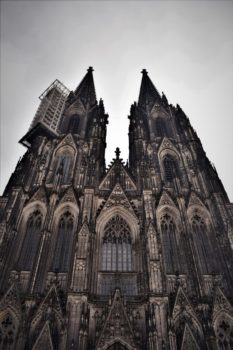The Petersglocke: Germany’s Massive Cathedral Bell Posted by Sten on Apr 19, 2021 in Culture, Music, Travel & Geography
The Petersglocke (f, St. Peter’s Bell) is one of the largest swinging bells in the world. It has its home in the Kölner Dom (m, Cologne Cathedral), a breath-taking cathedral with a long history and many records of its own. Known locally also as Dicker Pitter (Big Peter), the Glocke weighs about 24.000 kilograms (53.000 pounds) and measures 3.22 meters (10.5 feet) across at a height of 3.20 meters (10.5 feet). Until 2016, it was the biggest swinging bell in the world. It was overtaken by the Andreas Bell of the People’s Salvation Cathedral in Bucharest, Romania. However, it is still the tontiefste (lowest pitched) bell in the world. Here’s what came before it, how it sounds and how a tragic accident in 2011 was actually a blessing in disguise.
Its Predecessor: The War-Ridden Kaisersglocke
Before the Petersglocke, the Cologne Cathedral had another huge bell: the Kaiserglocke (f, Emperor’s Bell). This bell was made in 1874, shortly after the Franco-Prussian War of 1870-71. The Glocke was commissioned during the war. It was cast using captured Kanonen (f, canons) from the war that the Kaiser (m, emperor), Wilhelm I, donated for the bell. That’s why it bears the name Kaiserglocke.
However, as impressive as the bell was with its 26 metric tons and 3.5 meters diameter, it just didn’t sound right. However, that was not the reason that it was removed in 1918. The First World War required so much metal, that churches had to give up many of their most-prized possessions. Entire Orgeln (organs) were melted down to make war machines. The Kaisersglocke met the same fate. The bell that came from weapons returned to becoming one.
By the end of the war, the metal shortage got better, and the Kölner Dom wanted to get a new Glocke. Another one that could do the C0 pitch. That’s where the Petersglocke comes in.
The Petersglocke
The Petersglocke was gegossen (cast) in 1923 in Apolda by Heinrich Ulrich (a name can’t get more German than that). This is 1923, so we’re in the middle of the Great Depression, which hit Germany extremely heavily. The German currency, the Mark became worthless quickly. This was a problem for Ulrich, as casting a Glocke is an incredibly laborious process that takes months or even years to complete. And so, as a precaution, he demanded 5000 dollars extra pay to ensure he would be able to stay afloat.
To get the massive bell into the cathedral was no easy feat. Due to its width, the Petersglocke did not fit through the main doors of the Dom, and so the middle divider between the two doors had to be removed. But even once the bell was inside the church, it had to be pulled up into the Glockenstuhl (bell fry). It took several weeks to get it up the 53 meters tall Glockenstuhl.
But then it was done, and the Petersglocke made its amazing sound in c0 for decades – until 2011.
Klöppelabsturz
https://www.youtube.com/watch?v=cyXafu7XTQc
On January 6, 2011, something awful happened. The Klöppel (m, clapper) of the bell broke off. During the Glockenspiel (chime) of the Heiligen Drei Könige (Epiphany). The sound of the Klöppel hitting the floor of the Glockenstuhl was clearly audible, as you can hear in the video above.
But just 11 months later, the Petersglocke could sound again with a new Klöppel. In fact, it was a blessing that it received a new one. The old one hit the bell too hard and would have made it unusable in a few years. The new Klöppel, with a lower weight and a different Anschlag (m, impact), made for a better sound and longevity.
Have you heard the Petersglocke before, or have you visited the Kölner Dom? If not, check out our post on the Kölner Dom, and how you can visit from the comfort of your home!

Build vocabulary, practice pronunciation, and more with Transparent Language Online. Available anytime, anywhere, on any device.





Comments:
Alcazar:
Den Dicken Pitter kenn ich, auch wenn noch nicht in Köln war (ist z. Zt. auch etwas schwer mit Reisen…)
Waren Sie schon in Erfurt, im Mariendom?
Da hängt die Gloriosa, die größte freischwingende Glocke des Mittelalters.
Danke.
Sten:
@Alcazar Danke für den Kommentar. Die Gloriosa von Erfurt kenne ich noch nicht. Danke für den Tipp.
Ich glaube, ich werde in Zukunft mehr über Kirchen und das ganze drum und dran schreiben. In meiner Recherche zum Kölner Dom habe ich auch die Freiburger Wasserspeier entdeckt. Das sollte auch ein interessanter Artikel sein!
Allan Mahnke:
Terrific blog post! I really enjoyed the videos especially the last. Germany has done a great service by offering recordings of special church bells – including my family’s home parish church in Kittendorf.